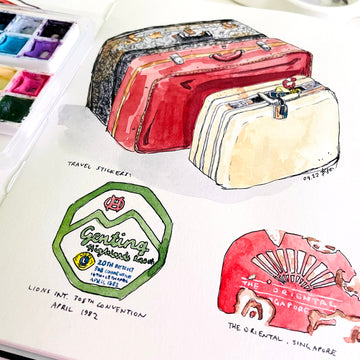One of the best things about painting and making art is that in a way, it immortalises the subject. From historical art pieces to even abstract art based on an emotion or concept, a record of something, somewhere is kept, whether it’s seen by the world or kept in the back of a drawer.
If you’re also interested in the old, the historic, and treasures of the past, here’s some tips on how to record them!
Form and Function

The most basic way of recording is to capture an object’s form. How is it shaped? What does it look like?
If you’ve seen a lot of antique items before, you may begin to notice a trend. Older things tend to be bigger and simpler in form compared to modern things. This makes it easier to draw and/or paint for sure!
Bonus tip: If you plan on drawing it, try doing it in pen from the get-go, and go for a thinner line quality to suggest its faded existence.

Another thing to note is an object’s function. In the above image, I’ve drawn the same old matchbox twice, but since its form was so simple (I mean, it’s just a box), I decided that I needed to record what its function was, too, and how the matches slide out of their compartment.
And while matchboxes still exist and are used today, maybe one day in the future, they become obsolete. So a record of the past is preserved, long after the object itself is gone.
Colour Palettes and Changes

Another way to note the old is the colour palette used. Old designs tend to be more limited in design and colour, as the printing process wasn’t very advanced back then.
So in the same way, limit your colour palette, and keep the colours bright in general, with little to no gradation (i.e. keep the colours flat, within their designated areas).
Bonus tip: You can also try painting outside your lines (if you have linework) or overlapping some of the colour edges, as a lot of printed things in the past were done via lino printing and would often be slightly misaligned.

Ageing also causes discolouration in many old objects, as colours fade or change over time. This is especially true for materials made back then – for example, paper generally used to yellow a lot faster than it does now, because they contained cellulose, which turns yellow-brown as it oxidises.
Plastics turned yellow as well, until scientists figured out how to make them without bromine. Metal on the other hand rusts, though the colour it turns into depends on what kind of metal was used (e.g. a green rust is produced by copper, bronze, and brass, while a brick red rust is produced by iron).
Tip: The best way to show these colour changes is to paint the original colour of the object first, then glazing the areas that have the material’s corresponding discolouration. For example, in the painting of the suitcases above, some parts of the plastic body were turning yellow, so I added a layer of yellow ochre after the base layer had dried.
Therefore, a good understanding of old materials and their “ageing colours” is helpful in order to make something look old! And they can be beautiful in their own way, too.
In Practice

Last but not least, the best way to make something look old is to paint something that is old! How about an abandoned truck, or some old ruins? Or your grandparents’ old LP record collection?
The reverse is true as well – if you want to make an old thing look new, imagine it without the broken-down pieces and the discolouration. Or do an online search if you’re not sure! Ultimately, it’s up to you to decide how you want to record the past, and present it to the future generations.
What old things have you seen or collected before? Do you keep a record of them, painted or otherwise? Let us know in the comments below! Also, for more tips and tricks about art, feel free to subscribe to our email newsletter.



2 comments
Great tips! Thank you
This was such a fun read! So many nice and practical tips – thank you :D
———
Etchr Lab replied:
We’re so glad it helped! Thank YOU for giving it a read. Please do let us know if there’s anything specific you’d like us to write about!
MARIELLE SOLOMON Marketing Manager
marielle@etchrlab.com
etchrlab.com | Instagram <https://www.instagram.com/etchr_lab/> | Facebook <https://www.facebook.com/EtchrArtClan/>
Etchd Lab Pty Ltd | ACN 617 485 444
———
Etchr Lab replied:
MARIELLE SOLOMON Marketing Manager
marielle@etchrlab.com
etchrlab.com | Instagram <https://www.instagram.com/etchr_lab/> | Facebook <https://www.facebook.com/EtchrArtClan/>
Etchd Lab Pty Ltd | ACN 617 485 444